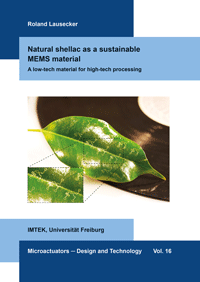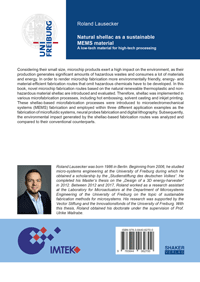
Shop : Details
Shop
Details
48,80 €ISBN 978-3-8440-6270-0Softcover172 pages75 figures305 g24 x 17 cmEnglishThesis
November 2018
Roland Lausecker
Natural shellac as a sustainable MEMS material
A low-tech material for high-tech processing
In contrast to their small size, microchip products exert a considerably high impact on the environment, as indicated by a high material and energy consumption as well as a high generation of hazardous wastes. In order to render microchip fabrication more environmentally friendly, energy- and material-efficient fabrication routes that omit hazardous chemicals have to be developed. Therefore, the non-hazardous material shellac, a natural renewable thermoplastic secreted by lice, was employed within novel fabrication routes for microchip products within this thesis. Shellac exhibits beneficial material properties for “green” processing, such as its low glass transition temperature or solubility in ethanol and isopropanol, which enable energy-efficient and hazard-free shellac-based microfabrication processes.
In this thesis, shellac was implemented within various microfabrication processes, including hot embossing, solvent casting and inkjet printing, which were introduced to microelectromechanical system (MEMS) fabrication and applied within three different application examples, as the fabrication of microfluidic systems, neural probes fabrication and digital lithography, and evaluated for their environmental impact. Therefore, the relevant mechanical, thermal and rheological properties of shellac as well as the wetting behavior and the chemical resistance in contact to different solvents and wet etchants were determined. The microfabrication processes utilized for shellac were analyzed and optimized based on theoretical models and on the results obtained from the previous material characterization. Using the optimized parameters, shellac structures with minimum feature sizes of 20 µm could be successfully fabricated through hot embossing, whereas shellac patterns with linewidths of 45 µm were fabricated using inkjet printing. Within the application examples of shellac-based micromachining to MEMS fabrication, shellac enabled the fabrication of microfluidic test chips at low process temperatures, thereby reducing the energy demand of the employed hot embossing process in comparison to commercial thermoplastic materials. Through being temporarily embedded in shellac, silicon test chips for neural probe applications could be successfully connected to polymer cables with embedded metal connections using surface micromachining. By using inkjet printing of shellac-based inks, the masking of metal thin films during wet etching could be performed without hazardous chemicals typically used within conventional photolithography.
In this thesis, shellac was implemented within various microfabrication processes, including hot embossing, solvent casting and inkjet printing, which were introduced to microelectromechanical system (MEMS) fabrication and applied within three different application examples, as the fabrication of microfluidic systems, neural probes fabrication and digital lithography, and evaluated for their environmental impact. Therefore, the relevant mechanical, thermal and rheological properties of shellac as well as the wetting behavior and the chemical resistance in contact to different solvents and wet etchants were determined. The microfabrication processes utilized for shellac were analyzed and optimized based on theoretical models and on the results obtained from the previous material characterization. Using the optimized parameters, shellac structures with minimum feature sizes of 20 µm could be successfully fabricated through hot embossing, whereas shellac patterns with linewidths of 45 µm were fabricated using inkjet printing. Within the application examples of shellac-based micromachining to MEMS fabrication, shellac enabled the fabrication of microfluidic test chips at low process temperatures, thereby reducing the energy demand of the employed hot embossing process in comparison to commercial thermoplastic materials. Through being temporarily embedded in shellac, silicon test chips for neural probe applications could be successfully connected to polymer cables with embedded metal connections using surface micromachining. By using inkjet printing of shellac-based inks, the masking of metal thin films during wet etching could be performed without hazardous chemicals typically used within conventional photolithography.
Keywords: microchips; microsystems; environment; microfabrication; sustainability
Available online documents for this title
DOI 10.2370/9783844062700
You need Adobe Reader, to view these files. Here you will find a little help and information for downloading the PDF files.
Please note that the online documents cannot be printed or edited.
Please also see further information at: Help and Information.
Please also see further information at: Help and Information.
| Document |  | Document | ||
| Type |  | |||
| Costs |  | 36,60 € | ||
| Action |  | Purchase in obligation and download the file | ||
| Document |  | Table of contents | ||
| Type |  | |||
| Costs |  | free | ||
| Action |  | Download the file | ||
User settings for registered online customers (online documents)
You can change your address details here and access documents you have already ordered.
User
Not logged in
Export of bibliographic data
Shaker Verlag GmbH
Am Langen Graben 15a
52353 Düren
Germany
Am Langen Graben 15a
52353 Düren
Germany
Mon. - Thurs. 8:00 a.m. to 4:00 p.m.
Fri. 8:00 a.m. to 3:00 p.m.
Fri. 8:00 a.m. to 3:00 p.m.
Contact us. We will be happy to help you.



